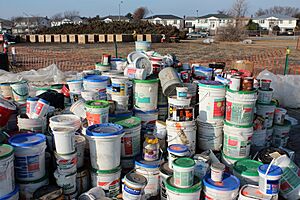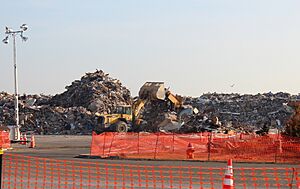Hazardous waste facts for kids

Hazardous waste is any type of trash that can be harmful to people, animals, or the environment if it is not handled properly. This kind of waste might be dangerous because it is poisonous (toxic), can burn or explode (reactive), or can eat through metal (corrosive).
Every year, people around the world create hundreds of millions of tons of hazardous waste. Common examples include old electronics, batteries, paints, and cleaning chemicals. Safely getting rid of this waste is very important for keeping our planet healthy and sustainable. There are special ways to dispose of it, such as storing it in secure landfills, burning it at very high temperatures, or recycling it into new things. Governments around the world create rules to make sure hazardous waste is managed safely.
Types of Hazardous Waste
Hazardous waste can come from many places, including our own homes. It's important to know what items are considered hazardous so we can dispose of them correctly.
Universal Waste
Universal wastes are common types of hazardous waste that many people and businesses produce. While they are less dangerous than some industrial wastes, they still need to be handled with care.
Some common examples of universal waste include:
- Fluorescent light bulbs
- Certain types of batteries, like those containing lithium or lead
- Old televisions and computer monitors with cathode-ray tubes
- Devices that contain mercury, like old thermometers
Because so many of these items are thrown away, there are special, simpler rules for recycling them to make it easier for everyone to do the right thing.
Household Hazardous Waste
Household Hazardous Waste (HHW) is any hazardous waste that comes from a home, not a factory or business. These are products you might buy at a store for cleaning, yard work, or hobbies.
Here are some common types of HHW you might find at home:
- Paints and Solvents: Leftover paint, paint thinner, and wood stain.
- Automotive Products: Used motor oil, antifreeze, and car batteries.
- Pesticides: Bug spray, weed killer, and chemicals for the garden.
- Mercury-Containing Items: Old thermometers and fluorescent light bulbs.
- Electronics: Old computers, televisions, and mobile phones (also called e-waste).
- Cleaners: Bleach, drain cleaners, and oven cleaners.
- Batteries: Especially rechargeable, button cell, or lithium batteries.
- Other Items: Asbestos (found in some old building materials) and some smoke detectors, which have a tiny amount of a radioactive substance.
How Is Hazardous Waste Disposed Of?
Hazardous waste cannot be thrown in the regular trash because it can leak and pollute the ground, water, and air. Instead, it must be treated in special ways to make it safe.
Recycling
Some hazardous materials can be recycled and turned into new products. For example, the lead from old car batteries can be melted down and used to make new batteries. Metals from electronic circuit boards can also be recovered and reused. This not only prevents pollution but also saves natural resources.
Incineration
Incineration is a process where hazardous waste is burned at extremely high temperatures (up to 1400°C). This can reduce the amount of waste by up to 90% and destroy many harmful chemicals. The process turns the waste into ash and gases. Modern incinerators have special filters to clean the gases before they are released into the air. The leftover ash is then taken to a special landfill.
Special Landfills
A hazardous waste landfill is very different from a regular landfill. It is built with thick plastic liners and layers of clay to create a barrier. This barrier prevents any harmful liquids from leaking out and contaminating the soil and groundwater. These landfills are carefully monitored to ensure they remain secure.
Pyrolysis
Pyrolysis is a high-tech method used for certain types of hazardous waste. The waste is heated to a very high temperature in a container with no oxygen. Without oxygen, the waste breaks down chemically without burning. This can turn dangerous materials into safer, more stable substances.
Why Safe Management Is Important
Handling hazardous waste correctly is crucial for protecting our health and the environment. If it's not managed properly, harmful chemicals can get into the air we breathe, the water we drink, and the soil where our food grows. This can cause serious health problems for people and wildlife.
Around the world, communities are working to manage waste more safely. The United Nations helps countries create plans for dealing with hazardous materials. One important international agreement is the Basel Convention. Nearly 200 countries have agreed to follow its rules, which aim to stop developed countries from sending their hazardous waste to developing countries that may not have the ability to handle it safely.
Managing waste properly is also a key part of the Sustainable Development Goals, which are global goals for a better and more sustainable future for everyone.
Rules and Regulations
To protect people and the environment, governments create strict rules for handling hazardous waste. These laws explain how waste must be stored, transported, and disposed of.
In the United States
In the United States, the United States Environmental Protection Agency (EPA) is in charge of these rules. The main law for this is the Resource Conservation and Recovery Act (RCRA). The RCRA creates a "cradle-to-grave" system, which means hazardous waste is tracked from the moment it is created until it is safely disposed of. This helps prevent illegal dumping and ensures that waste goes to the right facilities.
Many businesses, from large chemical factories to small businesses like auto repair shops, create hazardous waste and must follow these rules.
Around the World
Many other countries also have strong environmental laws. A major industrial accident in Bhopal, India, in 1984 showed the world how dangerous chemical waste could be if not managed properly. This event led India and many other nations to create stricter laws to prevent similar tragedies from happening again.
Courts and citizen groups often play a big role in making sure these laws are followed, helping to force companies to clean up pollution and dispose of waste safely.
See also
- Toxic waste
- Bamako Convention
- Brownfield Regulation and Development
- Environmental hazard
- Environmental remediation
- Gade v. National Solid Wastes Management Association
- List of solid waste treatment technologies
- List of Superfund sites in the United States
- List of waste management companies
- List of waste management topics
- List of waste types
- Mixed waste (radioactive/hazardous)
- National Priorities List (in the US)
- Pollution
- Recycling
- Retail hazardous waste
- Toxicity characteristic leaching procedure
- Triad (environmental science)
- Vapor intrusion




